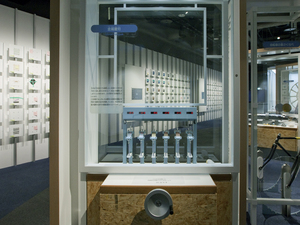Nagoya City Science Museum
TOP > Exhibition Guide > Keyword Search > Starting with "S" > strength > Metal Fatigue
Metal Fatigue



Purpose of Exhibition
When you rotate the handle, six kinds of metal plates vibrate. This actually makes a metal plate vibrate many times.
In this exhibition, metal fatigue is demonstrated by making it vibrate thousands of times and comparing plates when they break. The phenomenon of the failure of the material strength, when enduring repeated force, is called "fatigue".
In the case of metal it is called "metal fatigue", but it can occur in other materials.
Additional Knowledge
[Strength of Materials]
As for the strength of materials, there is mechanical strength, and the resistance to chemicals, corrosion and rust. In addition to mechanical strength, there are different strengths such as compressive strength, tensile strength against impact, and strength under low and high temperatures.
[Metal Fatigue]
Even a small tensile force can break metal by repetition. It is called "metal fatigue".
Many people probably remember that in 1985, a Japan Airlines jumbo jet crashed on the mountain of Osutaka in Gunma Prefecture, and it became a disaster.
At the time, an aircraft pressure bulkhead (wall partitioning the tail and the rear passenger room) was destroyed by metal fatigue. Because of this, the tail was destroyed and it caused a loss of control of the airplane and crashed. This plane landed by accident 7 years before, and because of some repairing errors, small cracks were created. The bulkhead receives pressure from the passenger room and at high altitude; the outside pressure is low, therefore, with such repetitive force acting on each flight, the cracks become enlarged.
Metal fatigue causes small cracks in metals, The repetition of the application of tension causes cracks gradually destroying the metal. When you observe this destroyed surface with your eyes, you will often find a concentric circle which is called "shell mark" or "beach mark". Its center is at the start point of the crack. When this destroyed surface is observed by a microscope, continuous stripes are visible.
The smaller the force applied, the more repetition it takes until it is destroyed.
By the way, unlike other metals, if the applied force is smaller than a certain power, the fatigue fracture does not occur, even if there is repetition.
There is no concern if you design using steel material with less force.
(1) Metal fatigue is not an academic term, but since the reported above accident, it is now widely used(2) In the statement "power" means precisely the "stress". The term "stress" means force per unit of area (the internal force caused against for the force acting from outside).
Article and illustrations by Keiko Ishida, curator
